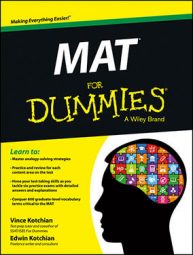The Miller Analogies Test (MAT) is a standardized test normally used for graduate school admissions. The test is composed entirely of analogies, so to do well, you have to adjust your thinking to fit the way analogies work.
People use analogies all the time in everyday speech. Analogies convey meaning by drawing comparisons. For example, you may say, “Trying to change my boss’s mind is like banging my head against a brick wall.” Banging your head against a wall is painful and futile, which illustrates how you feel about trying to change your boss’s mind.
On a standardized test, an analogy is a word problem composed of two different pairs of terms. The word problem is set up to reveal one set of terms first. Those two terms are related to each other in some way.
The problem then gives you the first term of the second pair and asks you to choose a second term to complete that pair. This second term must be related to the first term in the same manner in which the first pair of terms is related.
For example:
Black is to white as hot is to _________________
(A)great
(B)neutral
(C)cold
(D)gray
This basic analogy is asking you first to recognize the relationship between the terms black and white and then to pick a term that creates the same relationship. Because black is the opposite of white, the correct answer is Choice (C).
Black is to white as hot is to cold because cold is the opposite of hot.
Your ability to solve analogies offers insight into how you think. Both graduate programs and employers are interested in accepting people who can think, analyze, and reason, and looking at MAT scores is one way they attempt to determine whether an applicant has those abilities.
Analogies help people learn by creating connections in the mind. If a student is told to answer all the easy questions on a test before attempting any difficult ones, he’ll almost certainly understand the direction.
But if the student is given the analogy that answering the easy questions first is like grabbing the easiest coins first when you’re running out of time in Super Mario Brothers, he’ll have a mental image and create a stronger memory link to the concept. He’ll be able to link it to something he already knows, making it easier to remember and use in the future.
In fact, a lot of learning uses analogies, since people often fit new concepts into their existing knowledge by mentally comparing new facts to things they already know. Analogies aren’t bad; they’re actually pretty useful. Working on them might even make you smarter.
As with most skills, the more time you spend working on analogies, the better you get at them because your brain gets more used to identifying relationships. When you begin your MAT analogy practice, stick with it. Practice a little every day — before you know it, you’ll be able to zero in on most analogy relationships in no time.
So how do you find out if you’re good with analogies? In general, you’re more likely to be good with analogies if one or more of the following applies to you:
You quickly make connections between concepts and determine whether they’re related.
You’re a good teacher, or you’re good at explaining concepts in ways others can understand.
You like learning. You like Googling and researching on the Internet, just for fun.
You’re good with words, you have a good vocabulary, and you enjoy reading.
You’re good with puzzles and figuring things out.
You’re a creative person and enjoy creative expression.
This list isn’t comprehensive, but it may help predict whether you’ll adapt well to analogical thinking if you’re not al-ready good at it. Of course, to really determine whether you’re good at analogies, you have to work on a bunch of them and see how you do.

